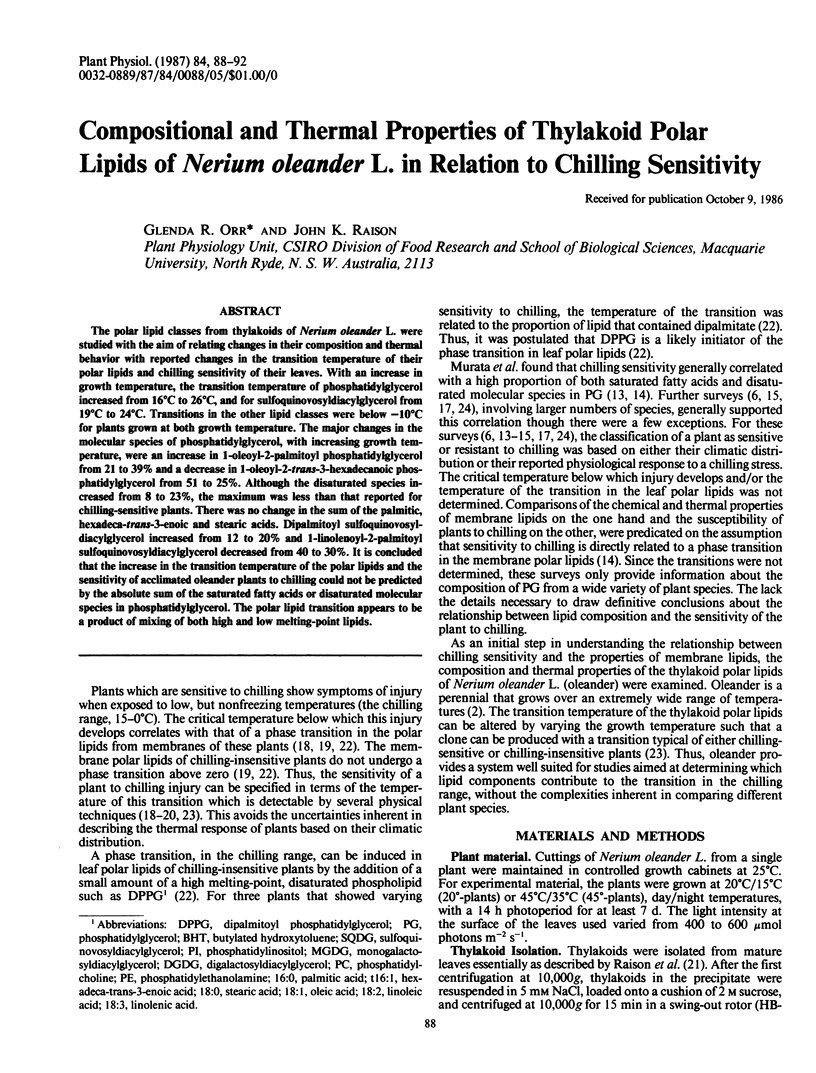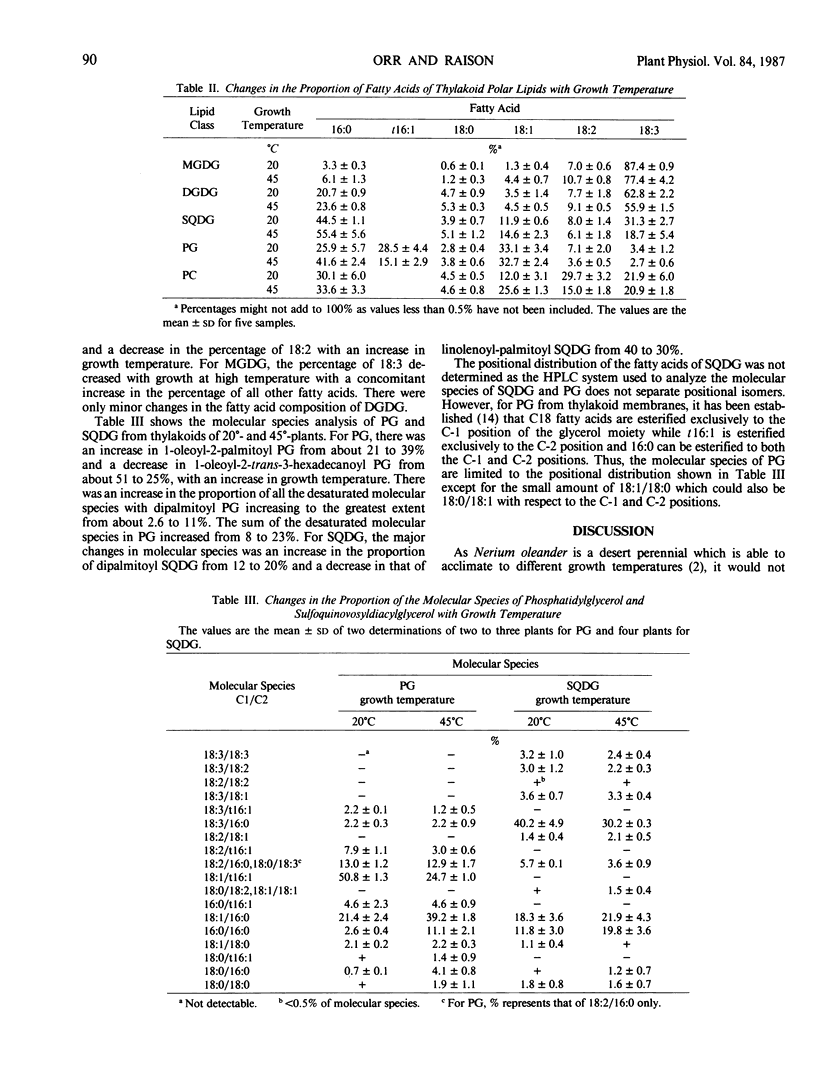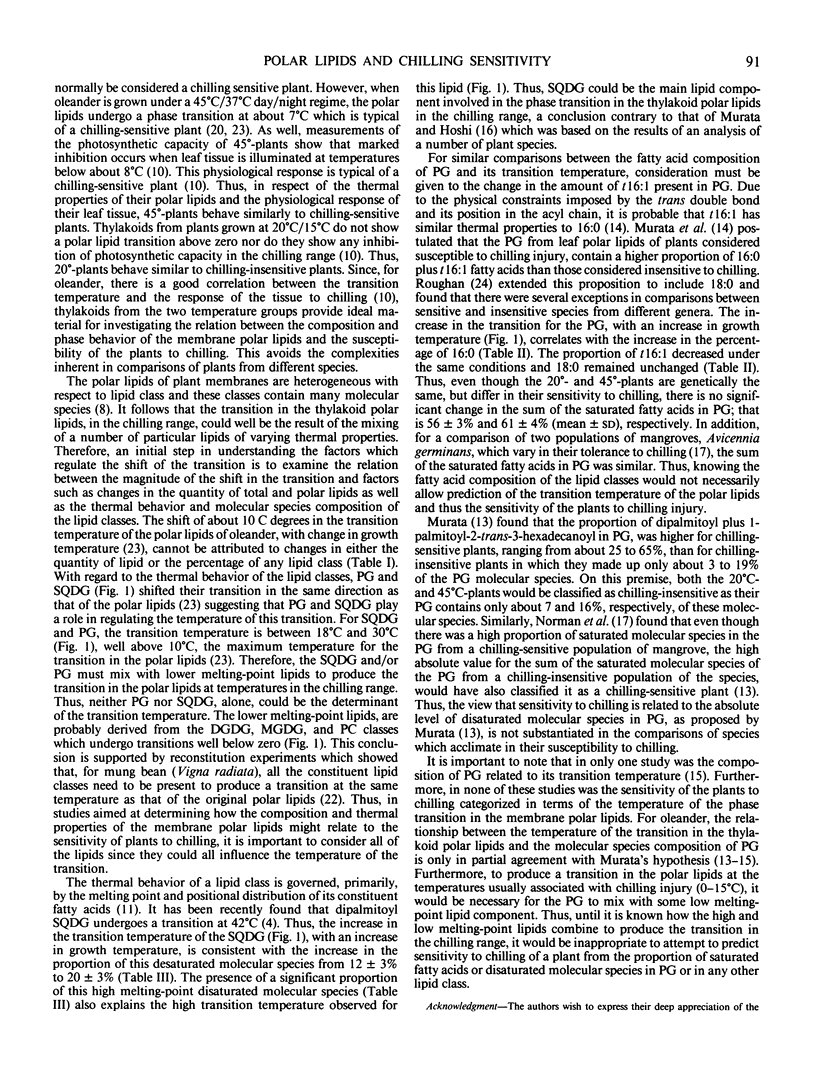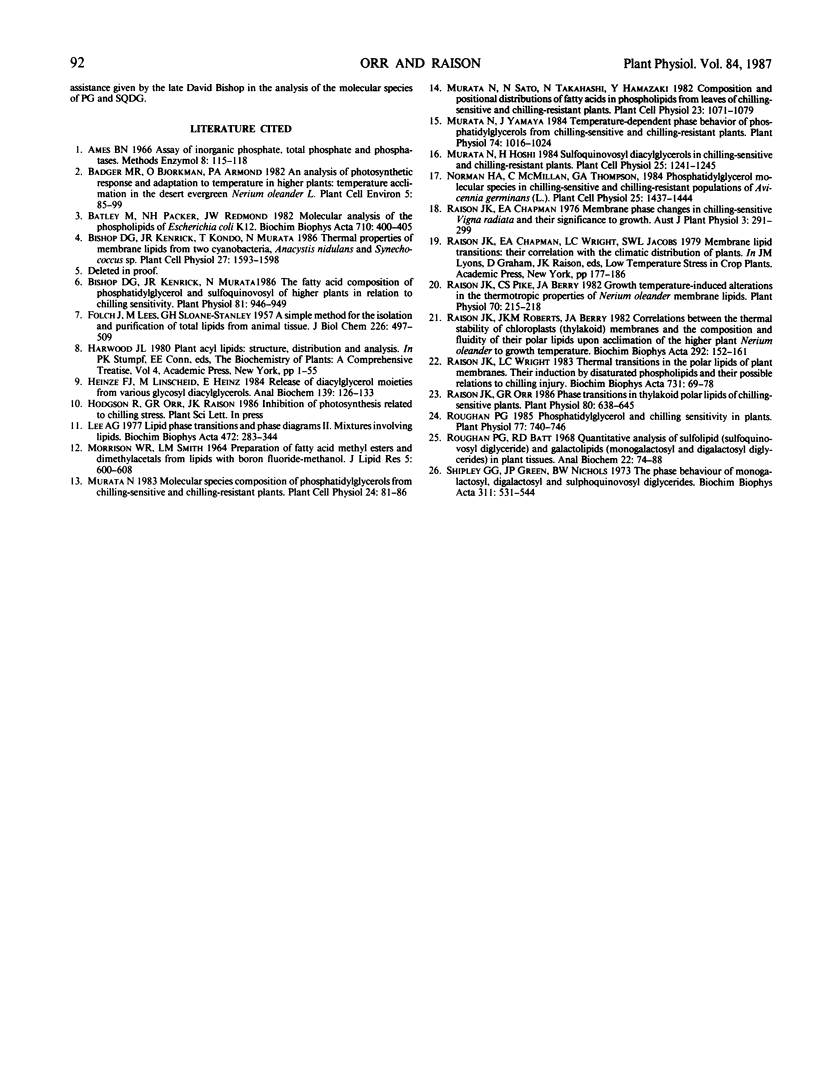Abstract
The polar lipid classes from thylakoids of Nerium oleander L. were studied with the aim of relating changes in their composition and thermal behavior with reported changes in the transition temperature of their polar lipids and chilling sensitivity of their leaves. With an increase in growth temperature, the transition temperature of phosphatidylglycerol increased from 16°C to 26°C, and for sulfoquinovosyldiacylglycerol from 19°C to 24°C. Transitions in the other lipid classes were below −10°C for plants grown at both growth temperature. The major changes in the molecular species of phosphatidylglycerol, with increasing growth temperature, were an increase in 1-oleoyl-2-palmitoyl phosphatidylglycerol from 21 to 39% and a decrease in 1-oleoyl-2-trans-3-hexadecanoic phosphatidylglycerol from 51 to 25%. Although the disaturated species increased from 8 to 23%, the maximum was less than that reported for chilling-sensitive plants. There was no change in the sum of the palmitic, hexadeca-trans-3-enoic and stearic acids. Dipalmitoyl sulfoquinovosyldiacylglycerol increased from 12 to 20% and 1-linolenoyl-2-palmitoyl sulfoquinovosyldiacylglycerol decreased from 40 to 30%. It is concluded that the increase in the transition temperature of the polar lipids and the sensitivity of acclimated oleander plants to chilling could not be predicted by the absolute sum of the saturated fatty acids or disaturated molecular species in phosphatidylglycerol. The polar lipid transition appears to be a product of mixing of both high and low melting-point lipids.
Full text
PDF




Selected References
These references are in PubMed. This may not be the complete list of references from this article.
- Batley M., Packer N. H., Redmond J. W. Molecular analysis of the phospholipids of Escherichia coli k12. Biochim Biophys Acta. 1982 Mar 12;710(3):400–405. doi: 10.1016/0005-2760(82)90123-0. [DOI] [PubMed] [Google Scholar]
- FOLCH J., LEES M., SLOANE STANLEY G. H. A simple method for the isolation and purification of total lipides from animal tissues. J Biol Chem. 1957 May;226(1):497–509. [PubMed] [Google Scholar]
- Heinze F. J., Linscheid M., Heinz E. Release of diacylglycerol moieties from various glycosyl diacylglycerols. Anal Biochem. 1984 May 15;139(1):126–133. doi: 10.1016/0003-2697(84)90397-x. [DOI] [PubMed] [Google Scholar]
- Kenrick J. R., Bishop D. G. The Fatty Acid composition of phosphatidylglycerol and sulfoquinovosyldiacylglycerol of higher plants in relation to chilling sensitivity. Plant Physiol. 1986 Aug;81(4):946–949. doi: 10.1104/pp.81.4.946. [DOI] [PMC free article] [PubMed] [Google Scholar]
- Lee A. G. Lipid phase transitions and phase diagrams. II. Mictures involving lipids. Biochim Biophys Acta. 1977 Nov 14;472(3-4):285–344. doi: 10.1016/0304-4157(77)90001-6. [DOI] [PubMed] [Google Scholar]
- MORRISON W. R., SMITH L. M. PREPARATION OF FATTY ACID METHYL ESTERS AND DIMETHYLACETALS FROM LIPIDS WITH BORON FLUORIDE--METHANOL. J Lipid Res. 1964 Oct;5:600–608. [PubMed] [Google Scholar]
- Murata N., Yamaya J. Temperature-dependent phase behavior of phosphatidylglycerols from chilling-sensitive and chilling-resistant plants. Plant Physiol. 1984 Apr;74(4):1016–1024. doi: 10.1104/pp.74.4.1016. [DOI] [PMC free article] [PubMed] [Google Scholar]
- Raison J. K., Orr G. R. Phase transitions in thylakoid polar lipids of chilling-sensitive plants: a comparison of detection methods. Plant Physiol. 1986 Mar;80(3):638–645. doi: 10.1104/pp.80.3.638. [DOI] [PMC free article] [PubMed] [Google Scholar]
- Raison J. K., Pike C. S., Berry J. A. Growth Temperature-Induced Alterations in the Thermotropic Properties of Nerium oleander Membrane Lipids. Plant Physiol. 1982 Jul;70(1):215–218. doi: 10.1104/pp.70.1.215. [DOI] [PMC free article] [PubMed] [Google Scholar]
- Roughan P. G., Batt R. D. Quantitative analysis of sulfolipid (sulfoquinovosyl diglyceride) and galactolipids (monogalactosyl and digalactosyl diglycerides) in plant tissues. Anal Biochem. 1968 Jan;22(1):74–88. doi: 10.1016/0003-2697(68)90261-3. [DOI] [PubMed] [Google Scholar]
- Roughan P. G. Phosphatidylglycerol and chilling sensitivity in plants. Plant Physiol. 1985 Mar;77(3):740–746. doi: 10.1104/pp.77.3.740. [DOI] [PMC free article] [PubMed] [Google Scholar]
- Shipley G. G., Green J. P., Nichols B. W. The phase behavior of monogalactosyl, digalactosyl, and sulphoquinovosyl diglycerides. Biochim Biophys Acta. 1973 Jul 18;311(4):531–544. doi: 10.1016/0005-2736(73)90128-4. [DOI] [PubMed] [Google Scholar]
- Shneyour A., Raison J. K., Smillie R. M. The effect of temperature of the rate of photosynthetic electron transfer in chloroplasts of chilling-sensitive and chilling-resistant plants. Biochim Biophys Acta. 1973 Jan 18;292(1):152–161. doi: 10.1016/0005-2728(73)90259-4. [DOI] [PubMed] [Google Scholar]


